How to competently deploy Wi-Fi at the hotel: typical questions and solutions
The Internet is now such an important part of a person’s life that the lack of access to a chain in a restaurant or hotel may well be the reason for refusing the services of the respective organizations. Let's talk about the features of the deployment of Wi-Fi-networks in the building of hotels, important parameters, as well as the hardware component.
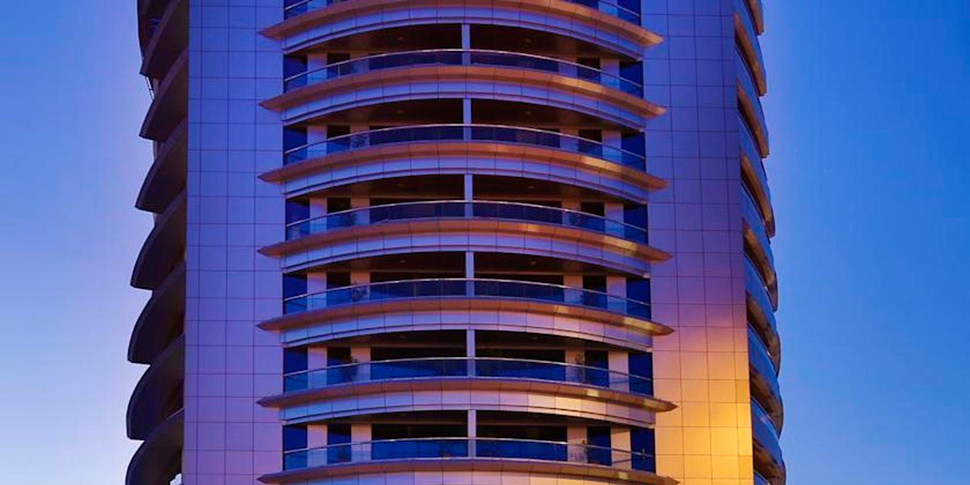
The fact that every modern hotel should have access to the Internet via Wi-Fi in its assets is not worth mentioning. However, the configuration of the premises and a number of other requirements and features make this task somewhat specific. It is important to assess the degree of signal propagation, to choose the right equipment, software, and at the same time avoid unnecessary costs.
In terms of wireless network deployment, a typical hotel is somewhat more complicated than an office open space or coffee house. Yes, the density of customer connections is not so high here, but the distribution of the signal is affected by walls, furniture, interior elements, pipes and other engineering structures. At the same time, for the final result (for providing quality service to the guests), the ratio of signal levels and noise in any place of a hotel room is extremely important. Therefore, even at the design stage of the network, it is necessary to conduct a full radio survey and radio planning, allowing to determine the optimal location of equipment.
')
Within this stage, specialized equipment and software will be involved. Equally important is information about the characteristics of objects located on the signal propagation path (up to the materials used). Typically, interference analysis is performed according to drawings and floor plans. The discrepancy between the actual situation and the plans can lead to critical errors in the results; therefore, it is advisable to supplement theoretical studies with practical measurements.
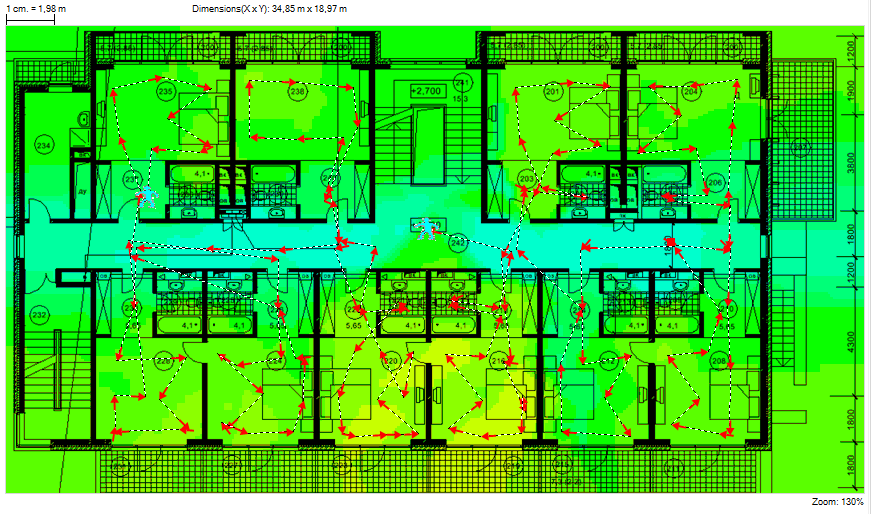
An example of a radio coverage map of a floor with guest rooms of a hotel where a radio survey was conducted
Even more difficult is the case with new hotels. Often, the customer still requires radio planning results at an early stage in order to design cable infrastructure. But finishing materials have a significant impact on the actual propagation of the signal, so the radio inspection of the concrete box gives practically meaningless results.
In such a situation, several equipped demo rooms are needed in which a radio survey is conducted. They are trimmed and furnished in the first place, and then on the basis of the obtained measurements (extrapolating them to other numbers) the cable infrastructure of the entire complex is designed.
There are two fundamentally different approaches to the formation of infrastructure for the provision of Internet access services. The first is the refinement of the existing solution in order to improve its characteristics. The second is the introduction of a new integrated solution.
Most hotels seek to optimize technological costs, so they choose the first way - redesign with improved coverage and network capacity, but retaining (if possible) already purchased equipment.
The second way is more in demand with new objects.
In any case, for the organization of quality access will need additional equipment. The volume of purchases is calculated based on the expected density of connections (an average of 4-6 numbers per access point).
When choosing a new device, one cannot but take into account the specifics of the hotel “guest” access - both from a technical and aesthetic point of view.
A good access point for hotels should be dual band. The device should provide load balancing, including through the Band Steering function, which allows clients to switch to the 5 GHz band with devices supporting it, freeing the band in the 2.4 GHz band (for devices that do not support the second band).

The new devices for wireless communications for premises (that is, those places where signal propagation is hampered by overlaps, furniture, etc.) provide Beamforming technology, which changes the conditions of signal transmission depending on the characteristics of the environment. The device determines which direction of the signal loss is greatest, and this task can be solved together with the subscriber device and the access point independently, depending on the standards supported by the client.
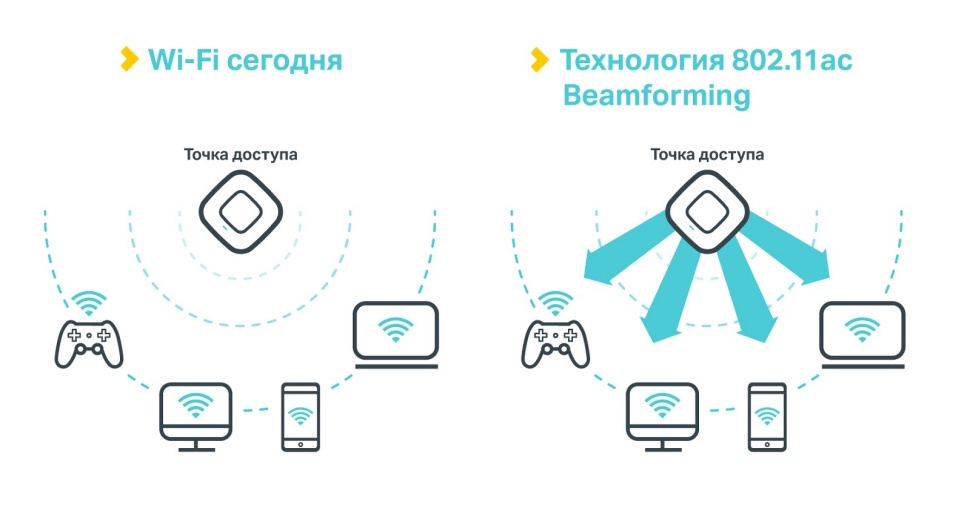
It is worth noting the technology that has already become mandatory in Enterprise: Airtime Fairness networks, providing protection against a “slow client”, which now cannot monopolize access point resources and does not degrade the overall network performance.
In addition, the point should fit into the interior of the hotel. Of course, it can be removed for a false ceiling, but this may affect the range of signal propagation, so it is recommended to keep the devices visible.
Access points designed for installation in rooms are often produced in the form of ordinary sockets, so as not to stand out. Access points for corridors and other premises are available in different buildings, have the function of disabling network indicators. Additionally, they are protected from theft, for example, using the Kensington lock.
To minimize the number of wires suitable for access points, modern devices use PoE (Power over Ethernet).
Such factors as ease of setup, features of access to the device via the web interface, etc. are taken into account in the second place, because it is assumed that the solution needs to be configured once, after which it will function without additional interventions. Although the hotels have their own additional wishes regarding the monitoring and adjustment of the purchased equipment.
If we are not talking about the development of individual solutions that involve specific previously purchased equipment, hotels may well use standard projects from large manufacturers. As an example of this approach - the project of building a wireless network in a hotel with 80 rooms based on our standard equipment.

The approximate cost of equipment for such a network is about six thousand US dollars.
Along with the equipment for providing wireless access, a convenient authorization system is often introduced, since the password printed on the check or written on one of the pages of the folder with the welcome information in the room is a remnant of the past, like a slow connection or permanent communication breaks.
Authorization via SMS or a page on social networks gives the hotel some information about the guest, which, when analyzed in bulk, allows you to change the parameters of the offer for the target audience. Technologies provide not only image advantages, but also completely monetized marketing data.
In addition, you can use mobile phone applications or similar services that are often provided in conjunction with IT partners to save on development.
Similarly, in partnership with leading legal OTT services, guests can offer streaming video as an alternative to hotel television.
One of the latest examples of the implementation of a comprehensive project on the organization of wireless access is Wi-Fi in the four-star City Seasons Dubai.
The hotel belongs to the network of one of the leaders of the hotel business of the UAE - City Seasons Group. The four-star hotels of the group in addition to Dubai are located in Abu Dhabi, Al Ain and Muscat.
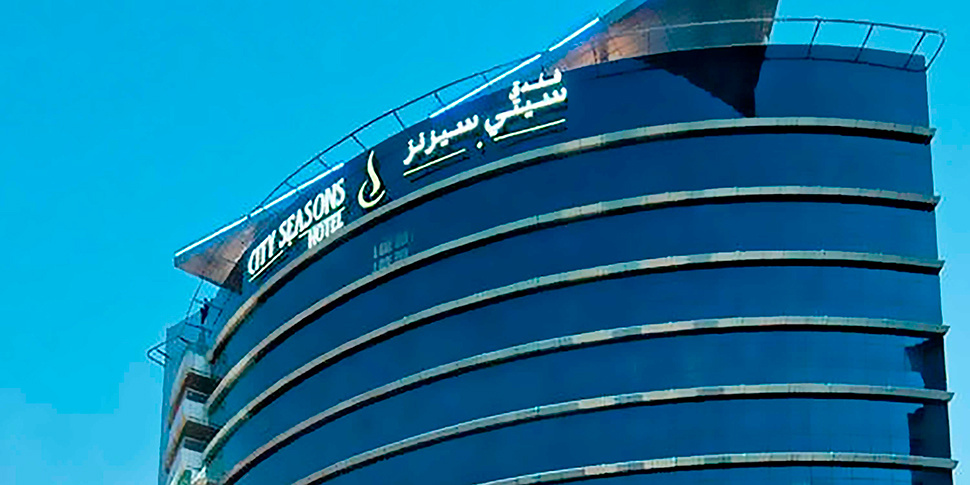
Earlier, City Seasons Dubai has already deployed a Wi-Fi network to provide guest access based on equipment from another supplier. However, it did not solve all the tasks of the hotel, in particular, the staff did not have the ability to centrally manage the network and monitor it. The need for these tools appeared during the development of the proposal for guests - primarily for the provision of additional services based on a wireless network. In addition, it was necessary to expand the coverage of the wireless signal and ensure seamless roaming between access points in all areas of the hotel.
As part of the project, access points EAP115-Wall were installed in hotel rooms, and EAP320 in other areas.
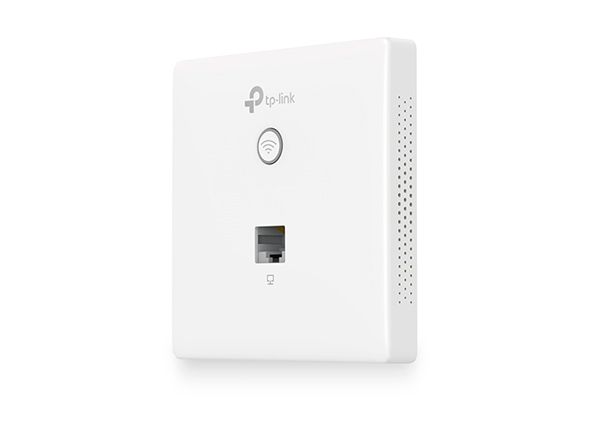
EAP115-Wall N300 Wi-Fi wall access point, PoE support, Auranet line
According to our partner, a Wi-Fi provider and a system integrator, Connectum, which specializes in similar projects of the hospitality industry in Russia, “EAP115-Wall is just that useful device from the practice that has entered the new editions of the leading hotel brands IT standards. . We are talking about placing such wall access points directly in the rooms, and not in the corridor, as was customary before. This provides a confident and stable reception, high speed transmission, load distribution from guests, who, returning to the hotel, suddenly begin to download movies and use the video link from the tablets.
The access point has a wired RJ-45 / Ethernet port, which can be used to deliver video content to a TV or connect an IP phone. ”

EAP320 AC1200 Gigabit Dual Band Overhead Wi-Fi Hotspot Auranet
802.11ac, MIMO, TurboQAM, Airtime Fairness, Beamforming, Band Steering, PoE
Additionally, a software EAP controller was implemented to control and monitor the network. The IT department of the hotel considered other offers (from other vendors), but the set of our equipment turned out to be optimal in terms of price and quality.
According to Treolink, which designs, installs and maintains computer networks for HoReCa customers, “TP-Link WiFi access points of the Auranet family provide wireless access to the network at speeds up to 1300 Mbps. On the basis of a software or hardware controller, they are combined into a seamless network in which access rights are flexibly differentiated, reservation and bandwidth limiting are set up, client authorization via SMS, social network profiles, temporary access vouchers. At the same time, in the guest Wi-Fi networks, the client devices are completely isolated both from each other and from the resources of the corporate network, which guarantees compliance with the company's information security policies. ”
In addition, do not forget about the wired part of the network. Our partners from Treolink comment: “Based on the TP-Link switchboards of the JetStream series, high-performance wired networks are being built and power is provided for devices that support PoE — Wi-Fi access points, surveillance cameras, telephone sets. Switches allow you to divide networks into logical, isolated segments, to configure access control lists, authorization. They are very stable, they support stacking and aggregation of ports, which very often helps out in complex scenarios when creating a core of large (over 1000 hosts) networks ”.
A wireless network with good coverage and stable Internet access opens up a lot of possibilities in front of the hotel. For example, it allows you to use mobile payment terminals at any point, install ATMs or other self-service terminals. In addition, it is possible to implement IT business automation tools through smartphones and tablets for staff, which allows you to simplify the management of individual services - banquet, maid, catering. And large global hotel chains are already testing various forms of mobile applications for the guests themselves, offering tools to meet their needs with minimal contact with the staff, which are available when connecting to the Internet or Wi-Fi of the hotel network, which is especially convenient for guests from other cities or countries .
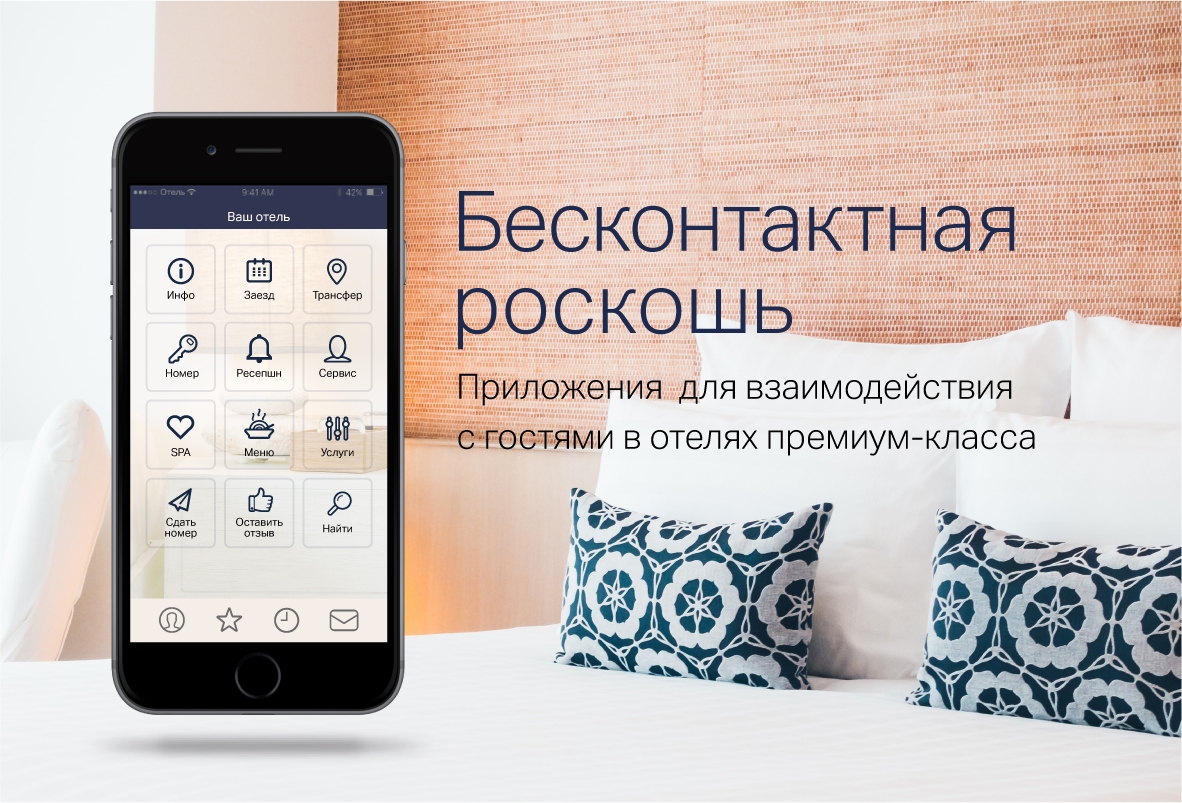

This trend is most noticeable in the luxury segment, where a separate term has already appeared for this phenomenon - low-touch luxury (or “contactless luxury” or contactless comfort) —that is premium service that can be obtained with minimal contact with staff.
There is another interesting service for foreign guests, according to Connectum: “It is useful for foreign visitors to offer Wi-Fi with them.” Having received a mobile LTE router at the counter in the lobby, the guest stays with hotel Wi-Fi anywhere in the city, which brings the art of hospitality to a new level. ”
By the way, we also have them, for example, the M7350 .
Not all of the listed services are necessary for a cheap boarding house, but the need for high-quality wireless access is practically independent of the stars and the target audience of the hotel. Best of all, this is currently understood in Moldova, Ukraine and Belarus - in these countries, according to a recent study by HomeToGo, 90 percent or more of vacation rental facilities have Wi-Fi. The top ten countries with the maximum "Internetization" of temporary housing includes Russia. Under these conditions, the renewal of infrastructure is no longer a question of competition with the closest neighbors in the market, but of survival among many hotels that have already expanded the range of their digital services.

The fact that every modern hotel should have access to the Internet via Wi-Fi in its assets is not worth mentioning. However, the configuration of the premises and a number of other requirements and features make this task somewhat specific. It is important to assess the degree of signal propagation, to choose the right equipment, software, and at the same time avoid unnecessary costs.
Planning
In terms of wireless network deployment, a typical hotel is somewhat more complicated than an office open space or coffee house. Yes, the density of customer connections is not so high here, but the distribution of the signal is affected by walls, furniture, interior elements, pipes and other engineering structures. At the same time, for the final result (for providing quality service to the guests), the ratio of signal levels and noise in any place of a hotel room is extremely important. Therefore, even at the design stage of the network, it is necessary to conduct a full radio survey and radio planning, allowing to determine the optimal location of equipment.
')
Within this stage, specialized equipment and software will be involved. Equally important is information about the characteristics of objects located on the signal propagation path (up to the materials used). Typically, interference analysis is performed according to drawings and floor plans. The discrepancy between the actual situation and the plans can lead to critical errors in the results; therefore, it is advisable to supplement theoretical studies with practical measurements.
An example of a radio coverage map of a floor with guest rooms of a hotel where a radio survey was conducted
Even more difficult is the case with new hotels. Often, the customer still requires radio planning results at an early stage in order to design cable infrastructure. But finishing materials have a significant impact on the actual propagation of the signal, so the radio inspection of the concrete box gives practically meaningless results.
In such a situation, several equipped demo rooms are needed in which a radio survey is conducted. They are trimmed and furnished in the first place, and then on the basis of the obtained measurements (extrapolating them to other numbers) the cable infrastructure of the entire complex is designed.
Equipment selection
There are two fundamentally different approaches to the formation of infrastructure for the provision of Internet access services. The first is the refinement of the existing solution in order to improve its characteristics. The second is the introduction of a new integrated solution.
Most hotels seek to optimize technological costs, so they choose the first way - redesign with improved coverage and network capacity, but retaining (if possible) already purchased equipment.
The second way is more in demand with new objects.
In any case, for the organization of quality access will need additional equipment. The volume of purchases is calculated based on the expected density of connections (an average of 4-6 numbers per access point).
When choosing a new device, one cannot but take into account the specifics of the hotel “guest” access - both from a technical and aesthetic point of view.
A good access point for hotels should be dual band. The device should provide load balancing, including through the Band Steering function, which allows clients to switch to the 5 GHz band with devices supporting it, freeing the band in the 2.4 GHz band (for devices that do not support the second band).

The new devices for wireless communications for premises (that is, those places where signal propagation is hampered by overlaps, furniture, etc.) provide Beamforming technology, which changes the conditions of signal transmission depending on the characteristics of the environment. The device determines which direction of the signal loss is greatest, and this task can be solved together with the subscriber device and the access point independently, depending on the standards supported by the client.

It is worth noting the technology that has already become mandatory in Enterprise: Airtime Fairness networks, providing protection against a “slow client”, which now cannot monopolize access point resources and does not degrade the overall network performance.
In addition, the point should fit into the interior of the hotel. Of course, it can be removed for a false ceiling, but this may affect the range of signal propagation, so it is recommended to keep the devices visible.
Access points designed for installation in rooms are often produced in the form of ordinary sockets, so as not to stand out. Access points for corridors and other premises are available in different buildings, have the function of disabling network indicators. Additionally, they are protected from theft, for example, using the Kensington lock.
To minimize the number of wires suitable for access points, modern devices use PoE (Power over Ethernet).
Such factors as ease of setup, features of access to the device via the web interface, etc. are taken into account in the second place, because it is assumed that the solution needs to be configured once, after which it will function without additional interventions. Although the hotels have their own additional wishes regarding the monitoring and adjustment of the purchased equipment.
Design and costs
If we are not talking about the development of individual solutions that involve specific previously purchased equipment, hotels may well use standard projects from large manufacturers. As an example of this approach - the project of building a wireless network in a hotel with 80 rooms based on our standard equipment.

The approximate cost of equipment for such a network is about six thousand US dollars.
| Name | Description | amount | Cost per unit, cu | Total price, cu |
| Gateway | ||||
| TL-ER6020 | SafeStream gigabit VPN router with 2 WAN ports | one | 147 | 147 |
| Switches | ||||
| T2600G-28TS | JetStream 24-port Gigabit Managed Layer 2 Switch with 4 SFP Slots | one | 270 | 270 |
| T1600G-28PS | JetStream 24-Port Gigabit Smart PoE + Switch with 4 SFP Slots | 2 | 400 | 800 |
| Access points | ||||
| CAP1750 | AC1750 Wi-Fi dual band gigabit ceiling access point | thirty | 153 | 4590 |
| AC50 | Wi-Fi hotspot controller | one | 48 | 48 |
| Total | 5855 |
Software components
Along with the equipment for providing wireless access, a convenient authorization system is often introduced, since the password printed on the check or written on one of the pages of the folder with the welcome information in the room is a remnant of the past, like a slow connection or permanent communication breaks.
Authorization via SMS or a page on social networks gives the hotel some information about the guest, which, when analyzed in bulk, allows you to change the parameters of the offer for the target audience. Technologies provide not only image advantages, but also completely monetized marketing data.
In addition, you can use mobile phone applications or similar services that are often provided in conjunction with IT partners to save on development.
Similarly, in partnership with leading legal OTT services, guests can offer streaming video as an alternative to hotel television.
Life example
One of the latest examples of the implementation of a comprehensive project on the organization of wireless access is Wi-Fi in the four-star City Seasons Dubai.
The hotel belongs to the network of one of the leaders of the hotel business of the UAE - City Seasons Group. The four-star hotels of the group in addition to Dubai are located in Abu Dhabi, Al Ain and Muscat.

Earlier, City Seasons Dubai has already deployed a Wi-Fi network to provide guest access based on equipment from another supplier. However, it did not solve all the tasks of the hotel, in particular, the staff did not have the ability to centrally manage the network and monitor it. The need for these tools appeared during the development of the proposal for guests - primarily for the provision of additional services based on a wireless network. In addition, it was necessary to expand the coverage of the wireless signal and ensure seamless roaming between access points in all areas of the hotel.
As part of the project, access points EAP115-Wall were installed in hotel rooms, and EAP320 in other areas.

EAP115-Wall N300 Wi-Fi wall access point, PoE support, Auranet line
According to our partner, a Wi-Fi provider and a system integrator, Connectum, which specializes in similar projects of the hospitality industry in Russia, “EAP115-Wall is just that useful device from the practice that has entered the new editions of the leading hotel brands IT standards. . We are talking about placing such wall access points directly in the rooms, and not in the corridor, as was customary before. This provides a confident and stable reception, high speed transmission, load distribution from guests, who, returning to the hotel, suddenly begin to download movies and use the video link from the tablets.
The access point has a wired RJ-45 / Ethernet port, which can be used to deliver video content to a TV or connect an IP phone. ”

EAP320 AC1200 Gigabit Dual Band Overhead Wi-Fi Hotspot Auranet
802.11ac, MIMO, TurboQAM, Airtime Fairness, Beamforming, Band Steering, PoE
Additionally, a software EAP controller was implemented to control and monitor the network. The IT department of the hotel considered other offers (from other vendors), but the set of our equipment turned out to be optimal in terms of price and quality.
According to Treolink, which designs, installs and maintains computer networks for HoReCa customers, “TP-Link WiFi access points of the Auranet family provide wireless access to the network at speeds up to 1300 Mbps. On the basis of a software or hardware controller, they are combined into a seamless network in which access rights are flexibly differentiated, reservation and bandwidth limiting are set up, client authorization via SMS, social network profiles, temporary access vouchers. At the same time, in the guest Wi-Fi networks, the client devices are completely isolated both from each other and from the resources of the corporate network, which guarantees compliance with the company's information security policies. ”
In addition, do not forget about the wired part of the network. Our partners from Treolink comment: “Based on the TP-Link switchboards of the JetStream series, high-performance wired networks are being built and power is provided for devices that support PoE — Wi-Fi access points, surveillance cameras, telephone sets. Switches allow you to divide networks into logical, isolated segments, to configure access control lists, authorization. They are very stable, they support stacking and aggregation of ports, which very often helps out in complex scenarios when creating a core of large (over 1000 hosts) networks ”.
Instead of conclusion
A wireless network with good coverage and stable Internet access opens up a lot of possibilities in front of the hotel. For example, it allows you to use mobile payment terminals at any point, install ATMs or other self-service terminals. In addition, it is possible to implement IT business automation tools through smartphones and tablets for staff, which allows you to simplify the management of individual services - banquet, maid, catering. And large global hotel chains are already testing various forms of mobile applications for the guests themselves, offering tools to meet their needs with minimal contact with the staff, which are available when connecting to the Internet or Wi-Fi of the hotel network, which is especially convenient for guests from other cities or countries .


This trend is most noticeable in the luxury segment, where a separate term has already appeared for this phenomenon - low-touch luxury (or “contactless luxury” or contactless comfort) —that is premium service that can be obtained with minimal contact with staff.
There is another interesting service for foreign guests, according to Connectum: “It is useful for foreign visitors to offer Wi-Fi with them.” Having received a mobile LTE router at the counter in the lobby, the guest stays with hotel Wi-Fi anywhere in the city, which brings the art of hospitality to a new level. ”
By the way, we also have them, for example, the M7350 .
Not all of the listed services are necessary for a cheap boarding house, but the need for high-quality wireless access is practically independent of the stars and the target audience of the hotel. Best of all, this is currently understood in Moldova, Ukraine and Belarus - in these countries, according to a recent study by HomeToGo, 90 percent or more of vacation rental facilities have Wi-Fi. The top ten countries with the maximum "Internetization" of temporary housing includes Russia. Under these conditions, the renewal of infrastructure is no longer a question of competition with the closest neighbors in the market, but of survival among many hotels that have already expanded the range of their digital services.
Source: https://habr.com/ru/post/331342/
All Articles